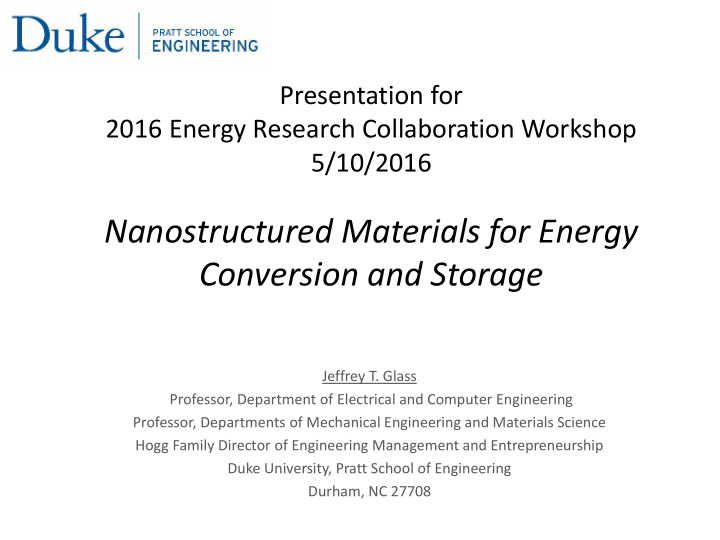



Presentation for 2016 Energy Research Collaboration Workshop 5/10/2016 Nanostructured Materials for Energy Conversion and Storage Jeffrey T. Glass Professor, Department of Electrical and Computer Engineering Professor, Departments of Mechanical Engineering and Materials Science Hogg Family Director of Engineering Management and Entrepreneurship Duke University, Pratt School of Engineering Durham, NC 27708
The Team and Funding Students: Isvar Cordova, Billyde Brown, Shane DiDona, Isa Ferrell, Phillip Herr, Philemon Henry, Erich Radauscher, James Thostenson, Akshay Raut, Barbara Raynal, Zach Russell, Doreen Wong, Stephen Ubnoske, Tanouir Aloui, Tasso von Windheim, Yihao Zhao Post Doc: Edgard Ngaboyamahina Research Scientists: Matt Kirley, Jason Amsden Lab Director: Charles Parker Collaborator: Brian R. Stoner, Sr. Research Fellow, RTI Int. Research Triangle Park, NC Funding: National Science Foundation (DMR & ECCS), Department of Homeland Security, National Institutes of Health, Gates Foundation, DOE ARPA-E, DARPA, DTRA 2
Capabilities • Plasma Enhanced Chemical Vapor Deposition • Atomic Layer Deposition of Oxides • In-vacuo XPS and UPS • Electrochemical Techniques Voltammetry, Electrochemical Impedance Spectroscopy (EIS), Potential Transient Measurements (PTM), Incident Photon Conversion Efficiency (IPCE) • Microfabrication (“MEMS”) – with RTI 3
Micro-patterned CNTs 50 m m
Vertically Aligned Graphene Nanosheets
Graphenated CNTs A hybrid structure of graphene foliates along the length of aligned multi-walled CNTs. 200 nm 200 nm 200 nm Parker et al ., Journal of Materials Research v27, p1046(2012)
Hybrid Graphene-CNT Nanostructures: Enhanced Energy Storage High capacitance achieved through hybrid graphene-CNT structure Increased deposition time correlates with increased graphene foliate density and leads to higher capacitance for energy storage .
Hybrid Graphene-CNT Nanostructures: Enhanced Catalytic Activity High catalytic activity achieved through hybrid graphene-CNT structure 200 nm CNT g-CNT C-V curves using the ferri-ferrocyanide couple to examine catalytic activity and electron transfer rates
Solar Fuels via Atomic Layer Deposition of Nanostructured Photoelectrodes Self-Limiting Growth Process Enables Deposition of Conformal and Uniform Ultra-Thin Films photon photon nanoFTO -OH O 2 2 μm TiO 2 Planar FTO Porous Heterostructure Design Enhances ALD Enables Optimization of Coating Energy Conversion Efficiency Thickness without Sacrificing Porosity
Solar Fuels via Atomic Layer Deposition of Nanostructured Photoelectrodes 60 TiO 2 (10nm)/nanoFTO 50 TiO 2 Nanowires Pure nanoFTO 40 IPCE (%) 30 20 1 m 10 0 300 330 360 390 420 450 Wavelength (nm) Incident Photon to Current Conversion Efficiency (IPCE) comparison Schematic of Photoconversion Mechanism (above) between our Heteronanostructure and TiO2 Nanowires Expected from our Nanostructure (below)
Additional Energy Applications of Interest • Miniature mass spectrometer for methane detection • Electrochemical disinfection for energy neutral off-grid toilet for the developing world 11
Coded Aperture Miniature Mass Spectrometer “The Ultimate Chemical Sensor” Energy Applications: Detection of rogue methane at well heads and refinery perimeters amu Microfabrication Process 500 microns
Aperture Coding: Results for Ethanol Traditional Magnetic Sector Mass Spectrometry with a Single Slit Single Slit Aperture Raw data Mass Spectrum Magnetic Sector Mass Spectrometry with a Coded Aperture showing a >10x signal gain Slit array Aperture Raw Data Mass Spectrum
Energy Neutral Off- Grid Toilets for the Developing World Electrochemical disinfection of liquid waste 14
Energy Minimization Mode Energy Disinfection (Wh/L) Time (mins/L) Continuous ON 5.59 15 Short-time 3.71* NA * Pulsed (50% DC) 3.76 20 Pulsed (10% DC) 1.91 48 * Disinfection was not achieved 66% energy saving by using 10% duty cycle pulsed mode as opposed to continuous ON mode Electrochemical Disinfection of Human Liquid Waste 15
Recommend
More recommend